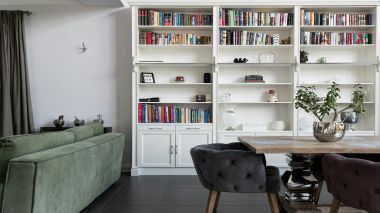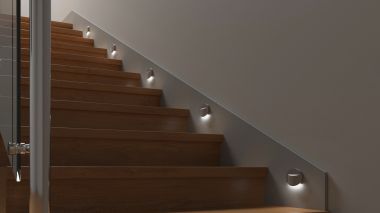How does LED lighting work?
The LED lighting in our homes, offices and public areas is here to stay. Today, it is hard to imagine interior design without this technology. Although LEDs are associated with modernity, their success is primarily due to their functionality and energy efficiency. Discover how this technology works, what types of light sources it offers, why it is so highly regarded and what to consider when choosing the right solution for us.

LED vs. traditional bulbs — the difference
Not so long ago, incandescent lighting was the standard both in homes and offices. They worked in a simple way — a heated filament emitted light. However, their biggest flaw was energy consumption: only a small proportion of the energy was converted into light (up to 10%) and the rest escaped as heat. Anyone who has ever tried to unscrew a traditional light bulb on knows this well.
With LED (Light Emitting Diode) lighting, the process is different. LEDs do not heat up (or heat up much less) mainly because they convert electrical energy directly into light, rather than into heat like the traditional incandescent bulbs. This process, called luminescence or electroluminescence, is more efficient. In some cases, especially with LED strips, higher temperatures can occur, but this is mainly due to the dense layout of the LEDs and lack of adequate heat dissipation. The use of heat sinks (e.g. aluminium profiles) can help dissipate heat and prevent overheating, thereby extending the life of LED strips. In addition, LEDs are more durable, resistant to damage (plastic bulbs instead of glass bulbs) and offer greater flexibility in light design (colour, light intensity).
Types of LED lighting
LED lighting today is much more than just the popular incandescent light bulbs in modern version. It is a diverse set of solutions which allows to build a lighting system tailored both to the user’s needs and the nature of the space. It includes many forms and solutions which differ in design, application and lighting effect. However, they all share a common feature: the use of semiconductor electroluminescence technology.
Individual LEDs are the basic components of this technology. In practice, they do not occur on their own (or very rarely) – they are usually combined in larger arrays to achieve adequate power and uniform light dispersion.
LED modules are ready-made circuits containing several or more LEDs installed on PCBs. Thanks to their compact design, they ensure high efficiency and easy installation. In our offer, this function is perfectly fulfilled by Kanlux MOD V2 – available in various power and colour temperature versions. Kanlux MOD LED is a professional series of modules dedicated to modification of lamps with old-type bulbs. The module is characterised by easy installation. The modules are usually installed in luminaires with an integrated source of light, that means they are pre-installed in the lamp and cannot be replaced.
LED tapes allow to form light in the space very easily. Flexible strips with densely spaced LEDs are perfect for illumination of alcoves, furniture or stairs. An example of such strips are Kanlux LED 24V tapes, which, thanks to their higher voltage, enable stable and even lighting even over longer distances. In addition, LED COB tapes are equipped with a “single continuous LED”, which ensures perfectly uniform light, eliminating concerns about brighter spots caused by individual LEDs.
LED bulbs are the replacement for traditional light sources – from classic shapes to spotlights and linear fluorescent lamps. Kanlux XLED with diodes arranged inside a glass bulb, allowing to obtain a lighting angle of up to 320°, which guarantees even illumination of the entire space, is particularly worth noting.
LED light ropes, such as Kanlux GIVRO series, make it possible to create uniform lines of light with no visible LED points. This is a perfect solution for illuminating building facades, gardens or modern interior design, where the effect of light continuity and resistance to external factors are essential.
LED lighting advantages
LED technology has revolutionised the approach to lighting — both in homes and commercial spaces. One of its biggest advantages is the energy efficiency. LEDs consume significantly less electricity than traditional equivalents, which translates into real savings on energy bills.
Their impressive durability is also significant — many models work for up to tens of thousands of hours, eliminating the need for frequent replacement. LEDs also allow incredible design flexibility: they are available in a variety of shapes, sizes and colour temperatures, making them suitable for any interior style and any room function. Their decorative potential is also of great significance — from subtle illumination to expressive lighting accents. All that makes LEDs not only a functional, but also an aesthetic lighting solution.
Luminaire or bulb control is also extremely convenient. In addition, no dimmers for this purpose are needed. All we need is a mobile phone and a free app to adjust the intensity, colour temperature or colour of the light.
What should be considered when selecting LED lighting?
When selecting a LED light source (bulb, luminaire or tapes), there are several key aspects to consider that affect the comfort and functionality of the lighting. First of all, the light colour temperature should match the purpose of the space. Warm shades (approx. 2700K) work well in bedrooms and living rooms, where a cosy atmosphere is important. A neutral colour temperature (approx. 4000K) is all-purpose and suitable for kitchens or offices, while a cool light (approx. 6500K) will find its use in garages or technical rooms.
Another significant parameter is the luminous efficiency, expressed in lumens per watt — the higher the value, the more efficient the light source. The CRI (Ra) index, on the other hand, which indicates the quality of colour rendering, should be at least 80 if accurate colour reproduction is desired. And don't forget the lighting angle: narrow angle is better for spot lighting, while wide angle — for general lighting. Finally, the selection should take the place of installation and its specifics into consideration: a bathroom, a kitchen and an entrance area of a house or office space will all have different requirements.
LED technology has undeniably changed the way we think about lighting — both functional and decorative. With the wide range of products available, we can create spaces that are not only well-lit, but also stylish and bespoke. By selecting tried and tested solutions, such as those from Kanlux, we invest in durability, efficiency and comfort for everyday use.
Other articles
 How to light your home library and reading space?
How to light your home library and reading space?
Reading is one of those activities that truly allows you to pause—to break away from everyday life...
 Lighting for Mezzanine Floors and High Spaces — Challenges and Solutions
Lighting for Mezzanine Floors and High Spaces — Challenges and Solutions
Not every space has the grandeur of a cathedral — and that is quite fortunate. Low interiors, mezzanine...
 Staircase and Corridor Lighting — Safety and Design
Staircase and Corridor Lighting — Safety and Design
Stairs, corridors and other passageways have specific lighting requirements. This is not only for safety...
 Smart lighting management in your home – where to start?
Smart lighting management in your home – where to start?
Smart lighting systems are not only a matter of convenience, but also a conscious step towards better...
 How does LED lighting work?
How does LED lighting work?
The LED lighting in our homes, offices and public areas is here to stay. Today, it is hard to imagine...
 How can lighting create a spa atmosphere in your bathroom?
How can lighting create a spa atmosphere in your bathroom?
When designing a bathroom, not only aesthetics but also lighting matter—when selected appropriately,...